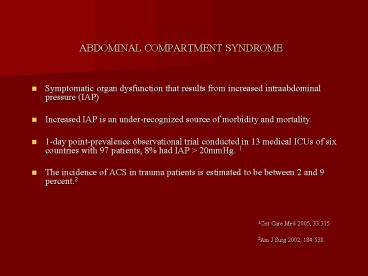ABDOMINAL COMPARTMENT SYNDROME - PowerPoint PPT Presentation
1 / 9
Title:
ABDOMINAL COMPARTMENT SYNDROME
Description:
ABDOMINAL COMPARTMENT SYNDROME Symptomatic organ dysfunction that results from increased intraabdominal pressure (IAP) Increased IAP is an under-recognized source of ... – PowerPoint PPT presentation
Number of Views:782
Avg rating:3.0/5.0
Title: ABDOMINAL COMPARTMENT SYNDROME
1
ABDOMINAL COMPARTMENT SYNDROME
- Symptomatic organ dysfunction that results from
increased intraabdominal pressure (IAP) - Increased IAP is an under-recognized source of
morbidity and mortality. - 1-day point-prevalence observational trial
conducted in 13 medical ICUs of six countries
with 97 patients, 8 had IAP gt 20mmHg. 1 - The incidence of ACS in trauma patients is
estimated to be between 2 and 9 percent.2
1Crit Care Med 2005 33315. 2Am J Surg 2002
184538.
2
ABDOMINAL COMPARTMENT SYNDROME
ETIOLOGY
- Massive volume resuscitation in the leading cause
of ACS. - Inflammatory states with capillary leak, fluid
sequestration, inadequate tissue perfusion, and
lactic acidosis can develop ACS. - Gastric overdistention following endoscopy has
resulted in ACS.
3
ABDOMINAL COMPARTMENT SYNDROME
PATHOPHYSIOLOGY
- The IAP is usually 0 mmHg during spontaneous
respiration, and is slightly positive in the
patient on mechanical ventilation. - IAP increases in direct relation to body mass
index, and in one report, supine hospitalized
patients had a mean baseline value of 6.5 mmHg. - The compliance of the abdominal wall generally
limits the rise in IAP but increases rapidly
after a critical IAP. - Critical IAP varies from patient to patient,
based on abdominal wall compliance on perfusion
gradient. - IAH often defined as IAP gt 12mmHg.
- Previous pregnancy, cirrhosis, morbid obesity,
may increase abdominal wall compliance and can be
protective .
4
ABDOMINAL COMPARTMENT SYNDROME
CLINICAL MANIFESTATIONS
CENTRAL NERVOUS SYSTEM ? Intracranial pressure ? Cerebral perfusion pressure CARDIAC Hypovolemia ? Cardiac output ? Venous return ? PCWP and CVP ? SVR PULMONARY ? Intrathoracic pressure ? Airway pressures ? Compliance ? PaO2 ? PaCO2 ? Shunt fraction ? Vd/Vt GASTROINTESTINAL ? Celiac blood flow ? SMA blood flow ? Mucosal blood flow ? pHi RENAL ? Urinary output ? Renal blood flow ? GFR HEPATIC ? Portal blood flow ? Mitochondrial function ? Lactate clearance ABDOMINAL WALL ? Compliance ? Rectus sheath blood flow
Curr Opin Crit Care 2005 11333
5
ABDOMINAL COMPARTMENT SYNDROME
- 50 mL of sterile saline is instilled into the
bladder via the aspiration port of the Foley
catheter with the drainage tube clamped. An
18-gauge needle attached to a pressure transducer
is then inserted in the aspiration port, and the
pressure is measured. The transducer should be
zeroed at the level of the pubic symphysis.
Curr Opin Crit Care 2005 11333
6
ABDOMINAL COMPARTMENT SYNDROME
MANAGEMENT
PROPOSED GRADING OF ABDOMINAL COMPARTMENT
SYNDROME
Grade Pressure (mmHg) Management
I 10-15 Maintenance of normovolemia
II 16-25 Volume administration
III 26-35 Decompression
IV gt35 Re-exploration
Abdominal perfusion pressure (APP) APP MAP
- IAP In one retrospective study, the inability
to maintain an APP above 50 mmHg predicted
mortality with greater sensitivity and
specificity than either IAP or MAP alone .
Surg Clin North Am 1996 76833.
7
ABDOMINAL COMPARTMENT SYNDROME
OPERATIVE DECOMPRESSION
Vacuum-assisted temporary abdominal closure
device thin plastic sheet, a sterile towel,
closed suction drains, and a large adherent
operative drape. This dressing system permits
increases in intra-abdominal volume, without a
dramatic elevation in IAP.
8
ABDOMINAL COMPARTMENT SYNDROME
SUMMARY
- ACS is a clinical entity caused by an acute,
progressive increase in IAP. - Multiple organ systems are affected, usually in a
graded fashion. - The gut is the organ most sensitive to IAH.
- Treatment involves expedient decompression of the
abdomen. - Since this syndrome affects patients who are
already physiologically compromised, a high
degree of suspicion and a low threshold for
checking bladder pressures are required to
prevent the mortality associated with this
complex problem.
9
ABDOMINAL COMPARTMENT SYNDROME
REFERENCES AND READINGS
- Sugrue, M. Abdominal compartment syndrome. Curr
Opin Crit Care 2005 11333. - Bailey, J, Shapiro, MJ. Abdominal compartment
syndrome. Crit Care 2000 423. - Malbrain, ML, Chiumello, D, Pelosi, P, et al.
Incidence and prognosis of intraabdominal
hypertension in a mixed population of critically
ill patients a multiple-center epidemiological
study. Crit Care Med 2005 33315. - Kron, IL, Harman, PK, Nolan, SP. The measurement
of intra-abdominal pressure as a criterion for
abdominal re-exploration. Ann Surg 1984 19928. - Hong, JJ, Cohn, SM, Perez, JM, et al. Prospective
study of the incidence and outcome of
intra-abdominal hypertension and the abdominal
compartment syndrome. Br J Surg 2002 89591. - Balogh, Z, McKinley, BA, Cocanour, CS, et al.
Secondary abdominal compartment syndrome is an
elusive early complication of traumatic shock
resuscitation. Am J Surg 2002 184538. - Cheatham, ML, White, MW, Sagraves, SG, Johnson,
JL. Abdominal perfusion pressure a superior
parameter in the assessment of intra-abdominal
hypertension. J Trauma 2000 49621.































